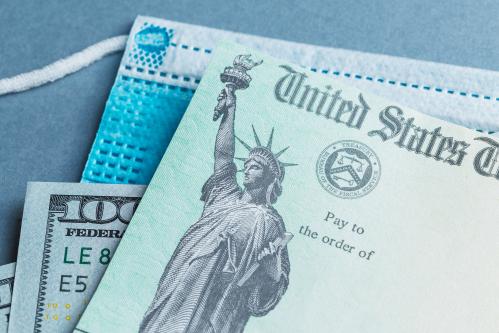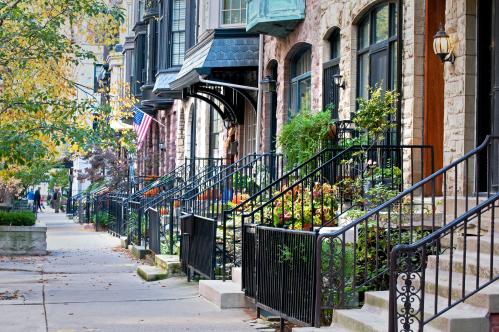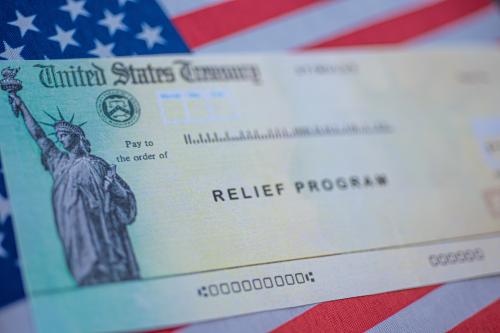This analysis is part of the American Rescue Plan: Strategies for Local Leaders series, a feature of the COVID-19 Metro Recovery Watch.
Small business stabilization is a central plank in the nation’s economic response to COVID-19. Over the last 12 months, the federal government has provided $932 billion in small business loans and advances—a scale that is without precedent.
Yet even with massive federal relief, small businesses were still reporting significant challenges in the first quarter of 2021. Depending on the estimate, between 25% and 30% of small businesses remained closed as of the beginning of this year. As of March 2021, 44% of small business owners reported operating below capacity compared to a year ago, and 53% expected it would take at least four months to return to normal operating levels, if ever.
Recognizing these challenges, Congress passed the American Rescue Plan Act (ARP) in March, providing further small business relief, including:
- A $7.25 billion expansion in the Paycheck Protection Program (PPP)
- $15 billion made available to the Small Business Administration (SBA) to provide $10,000 grants to certain eligible small businesses
- $29 billion to capitalize a Restaurant Revitalization Fund
- $1.25 billion to support shuttered venue operations (e.g., concert venues, museums, and theaters)
- $10 billion for a State Small Business Credit Initiative (SSBCI)
Notably, ARP also provides $350 billion in flexible fiscal aid to local and state governments, which they can use to support small businesses affected by the crisis, among other priorities.
With these resources, local governments—and the networks of civic, business, and philanthropic leaders that support them—are now the proverbial dog that has caught the car. After a year of providing on-the-ground support to small businesses to access PPP funds and overseeing modest local small business relief funds, ARP has given cities more financial autonomy to stabilize small businesses and catalyze local economic recovery.
But even with this flexible support, cities would still be wise to leverage federal and state funds that they do not control. Between ongoing federal relief programs, flexible local funds, and the state-controlled SSBCI initiative, it is going to take smart federalist approaches—organized locally—to support an inclusive small business recovery.
How should local leaders approach this responsibility? This brief argues that local leaders should take advantage of ARP’s opportunities with their own “A-R-P” process:
- Avert small business destruction
- Reassess small business recovery needs and outcomes
- Prioritize small business ecosystem investments
Avert small business destruction
Small business is a tough business. Even in a normal economy, over 40% of small businesses only break even or operate at a loss. Businesses are constantly being created and destroyed. This churn creates a risky journey for individual business owners, but can be a good thing for regional and national economies to the extent that it represents the “creative destruction” that creates economic progress. Unfortunately, COVID-19’s small business shock is “destructive destruction.” Some small businesses were better prepared for it, but many are struggling because of necessary regulations to guard public safety—not due to being less productive than their competitors.
Therefore, the first step for local leaders is actually a continuation of their work in 2020: averting further destruction. This involves investing in networks that provide the information, marketing, and technical assistance that can connect as many small businesses as possible to federal pools of small business relief.
PPP has been extended to May 31, 2021. The Restaurant Revitalization Fund will open in April. The SSBCI state-led programs will be launching soon. These federal programs are not perfect, but now include provisions that address early challenges to equitable PPP access, particularly for microbusinesses, sole proprietorships, and minority-owned businesses, as well as the continuing challenges for hospitality and leisure businesses.
Using resources from March 2020’s CARES Act, many cities built technical assistance and outreach networks for their small businesses. They should now use ARP to bolster and expand those networks through grants to chambers of commerce, community-based nonprofits, and entrepreneurship support organizations—any entity that has connectivity and trust with small business owners. These networks can deploy trusted brokers to connect small businesses to capital and keep them afloat until consumer demand returns this summer and fall. (For local examples of these networks, see case studies on Colorado, Detroit, and Indianapolis.) Another ARP provision—SBA’s Community Navigator Pilot Program—is designed to support these local networks with competitive grants.
It may still be necessary to recapitalize local small business relief funds, but it makes more sense for cities to first use ARP to invest in the outreach infrastructure to connect small businesses to federal relief.
Reassess small business recovery needs and outcomes
Averting small business destruction should be a priority until public health restrictions begin to lift or large federal small business relief programs end. Both will likely occur sometime this summer. When federal resources become less available, cities will have to reassess the ongoing needs of small businesses, the state of the small business support ecosystem, and the broader recovery outcomes they want to pursue.
Once federal funds are exhausted, cities will face hard choices about how they deploy their own state and local recovery funds to support small businesses. It is not yet clear when or how city councils, mayors, and county leaders will deploy ARP funds, but early indications suggest that many of these decisions will take place this summer.
Elected officials will ultimately bear responsibility for whether and how ARP is used to support small businesses, but this reassessment need not be led by overtaxed city staff. Rather, mayors and county leaders should assemble a small, high-capacity small business working group, with participation from the city and external stakeholders such as entrepreneurial support providers, banks, community development financial institutions (CDFIs), community-based groups, and small business owners themselves. Local research universities or business school professors could provide research support as well.
This group should try to accomplish three things: 1) assemble the best data—either through national sources or, more likely, local surveys—on the state of the small business recovery in their region and ongoing small business needs; 2) conduct an institutional assessment of the small business ecosystem; and 3) summarize those findings for elected officials to inform the deployment of ARP funds. These assessments can also inform future waves of federal investment, such as the proposed $31 billion in programs to support small business access to credit, venture capital, and research and development in President Joe Biden’s recently announced American Jobs Plan.
The assessment should focus on providing tailored offerings across three main domains: capital, coaching and connections, and community infrastructure such as incubators, accelerators, and co-working spaces. An institutional assessment should seek to summarize the landscape of existing business support entities, get a sense of current outcomes (this is harder than it seems), and identify critical gaps. It is not uncommon for cities to bundle these offerings by business type (tech-enabled startups, non-tech tradable or supply chain small businesses, and Main Street businesses) and businesses’ growth stage.
Prioritize small business ecosystem investments
The reassessment will give local communities a better shot at investing resources from ARP wisely. In a prior post, Brad Whitehead and I wrote that “we may look back at this time and ask: Which places merely spent their money, and which places invested it?” That piece offered four principles for cities to keep in mind as they strategize: immediacy, inclusivity, future prosperity, and complementarity. Larger investments in entrepreneurship and small business growth would ideally balance all four principles while acknowledging there may be tensions between them.
Cities that undertook extensive strategic recovery planning exercises this summer may already have a list of catalytic investments. The city of Chicago, for example, has over a dozen tactics under the broader strategic objective of creating “the most vibrant SMB [small and medium businesses] and Black- and brown-owned business community in America,” ranging from structured bankruptcy support to city process reforms to new financing vehicles. Other cities will need to use the reassessment period to seed similar strategies.
Regardless of the starting point, city leaders would do well to recognize that ARP—in addition to stabilizing basic government services—is a once-in-a-generation opportunity to invest in the building blocks of more competitive, racially equitable regional economies. Spending ARP resources as fast as possible may earn near-term political points, but only investing smartly in strategic initiatives will alter longer-term regional trajectories.
Small businesses—and the entrepreneurs that start and scale them—can be a critical component to regional recovery strategies, and benefit from investments in new capital structures, collaborative technical assistance networks, supply chain initiatives, and community infrastructure upgrades. Yet, if cities want to make significant platform investments in small business support, they must ensure they are inclusive, durable, and evidence-based. Importantly, ARP’s two-tranche funding sequence gives cities until spring 2022 to plan the deployment of the second tranche.
Balancing relief and recovery in the months ahead
Even though the American Rescue Plan has been billed as the Biden administration’s “relief package”—with “recovery packages” focused on the nation’s physical and human infrastructure forthcoming—city leaders are treating ARP as a balance between relief and recovery. Where cities ultimately strike that balance will vary based on local economic conditions, institutional capacity, and political priorities.
As elected officials wrestle with those decisions, they should know that ARP will be their best—and maybe only—shot at stabilizing small businesses and helping them recover. In the coming weeks, Brookings Metro will provide a series of products that offer practical guidance to city leaders as they reassess their small business needs and prioritize transformative investments in support of a dynamic and equitable small business economy.








Commentary
Washington has supplied the dollars to save small businesses, but local leaders need to supply the strategy
April 5, 2021